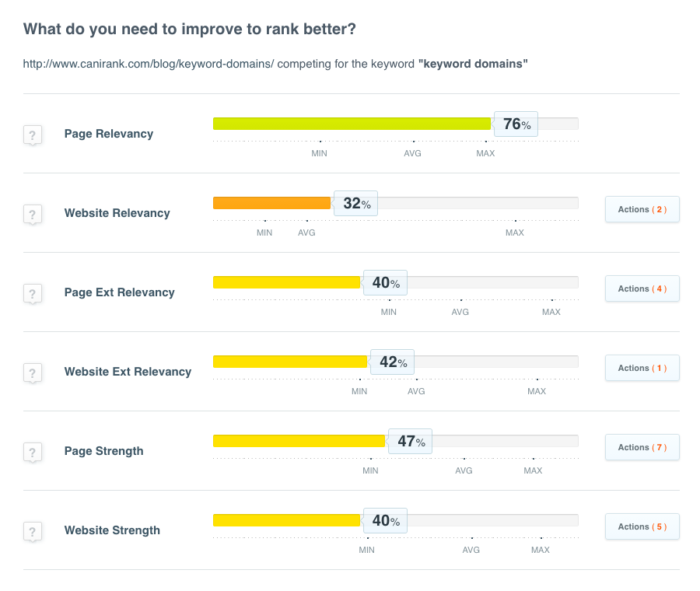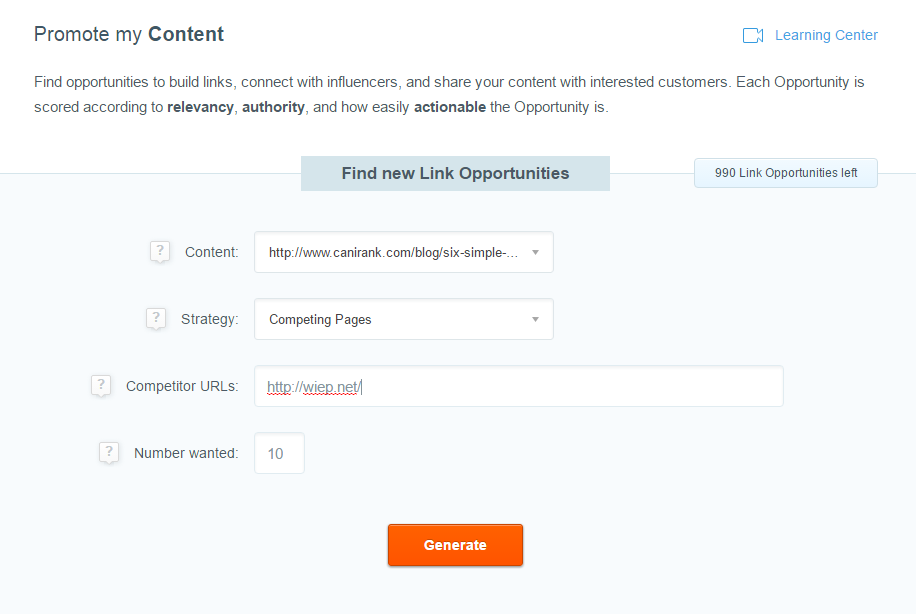Planning and executing a major content marketing and SEO strategy can be time-consuming and very expensive, especially if it fails. While SEO isn’t necessarily as expensive as paid ads, it does require a substantial amount of effort to successfully implement.
Instead of taking a large jump and risking failure, what if there was a way we could take many small SEO steps and guarantee success? Turns out, there is.
The Lean Startup is a methodology used to develop products and businesses efficiently. Businesses are created through a process of validating many hypotheses, one by one, using the scientific method.
Simply put, it means:
- Launch a small iteration.
- Test it.
- Determine if the test was successful.
- Use what you learned to introduce the next iteration.
For marketers and businesses looking to establish themselves on search engines, many Lean Startup principles are applicable. In this post, we explore the Lean Startup method and examine how to apply these techniques to SEO.
Why Validated Learning Improves SEO
According to the Lean Startup, learning is one of the most valuable activities in building a business. Improving your SEO strategy through consistent education is equally as effective. Regarding validated learning, the Lean Startup says:
“You can’t take learning to the bank; you can’t spend it or invest it. You cannot give it to customers and cannot return it to limited partners… Yet, if the fundamental goal of entrepreneurship is to engage in organization building under conditions of extreme uncertainty, its’ most vital function is learning. We must learn the truth about which elements of our strategy are working to realize our vision and which are just crazy. We must learn what customers really want, not what they say they want or what we think they should want.”
Marketers often consider a first-page search engine ranking to be a huge win.
However, ranking as #1 for a keyword isn’t a success at all if:
- Nobody ever searches for that keyword.
- Traffic follows that keyword to your page but bounces off quickly because they didn’t find what they expected.
- Visitors never convert to customers.
Validated learning allows marketers to test their assumptions before deciding what keywords to target, what content to write, and what influencers to pitch to promote their content. By conducting a series of small tests, marketers can ensure that their strategies are sound before making a huge investment in their pursuit. It’s all about brains over budget!
What Are You Trying to Prove?
The Lean Startup approach doesn’t exist to answer the question, “Can this product be built?” but instead seeks to answer, “Should this product be built?”. In today’s age, anything can be made, but not everything should be created.
In the case of SEO and content marketing, any topic can be targeted, and any content can be written, but that doesn’t mean that it should be written or that consumers are going to care enough to read it.
Before making any SEO decisions, prove that it is the action that you should be taking:
- When choosing keywords: Any keyword can be targeted, but should it be targeted?
- When choosing a niche audience: Any audience can be targeted, but should they be targeted?
- When promoting content: Any influencer can be targeted, but which influencers should be targeted for a particular piece of content?
How Lean Startup SEO Works
Lean Startup uses an agile/scrum approach to innovation by implementing a “Build-Measure-Learn” feedback loop. In practice, it means identifying a problem that needs to be solved, launching a minimal solution, and learning as quickly as possible. As opposed to spending time developing a full product, agile businesses build a small piece of their idea in a short work cycle, evaluate customers’ reactions, and then use what they have learned to decide what they should build next.
Lean Startup says,
“Too many startups begin with an idea for a product that they think people want. They then spend months, sometimes years, perfecting that product without ever showing the product, even in a very rudimentary form, to the prospective customer. When customers ultimately communicate, through their indifference, that they don’t care about the idea, the startup fails.”
There is a similar process that most marketers take when developing their SEO strategy. They target a keyword and topic for which they think people will search. They spend days, weeks, sometimes months, perfecting an impressive piece of content without ever showing it (even in a very rudimentary form) to their prospective audience.
When readers or influencers ultimately communicate, through their indifference, that they don’t care about the idea, the content quickly gets forgotten and becomes a waste of time and resources. Avoiding this using the Lean Startup methodology is the basis of lean startup SEO. So, the question we need to answer is: how do we do lean startup marketing?

How can the Build-Measure-Learn feedback loop be used to prevent this dilemma as it relates to content marketing and SEO? Consider the following Lean SEO tips.
When Choosing a Keyword/Topic
Instead of assuming that your audience is searching for insight on a certain subject, look through forums and related social groups to see how often the topic comes up. Communities like this are great tools for startups.
If people ask about the issue frequently, assume it’s an important subject to which people aren’t able to find an answer. Should you discover that no one at all is asking about or interested in the topic — this likely won’t change just because you write a great article.
When Pitching Influencers
You only get one chance to make a great first impression when asking influencers to link to your content. Learn how to pitch your article successfully by pitching to the least significant influencers on your list first. They’re the ones with the least domain authority, who will have the least impact if they promote your link.
If your pitch can’t attract attention from “Bob’s Business Blog,” it’s not likely that Forbes is going to jump at the chance to mention your content either. Test your pitch often, and once you know you have a winning pitch, use it to win over bigger influencers to promote your content.
When Optimizing On-Site
There are many factors that Google considers when determining which sites are most relevant to specific keywords. Use SEO competitor analysis software to determine how ranking competitors are using primary and related keywords.
Don’t assume that your content is optimized perfectly after the first run. Allow it to run for a week or two, and then analyze how those optimizations have affected rankings. Make small tweaks, and after a week, analyze rankings again. Repeat these steps until your article is maximally optimized.
When Optimizing for Traffic Conversions
Being ranked on a first page doesn’t automatically equate to clicks. Sometimes, the link’s snippet doesn’t assure the reader that your content will answer their question.
Instead of relying on one single snippet, write several and compare them using A/B testing. Run one snippet for a week, analyze the results, then change it out for another one. Do this until your snippet converts the ideal number of viewers into site visitors.
When Pitching Guest Posts
Just like with blog content, writing guest posts can be a waste of time if your audience members (industry influencers in this case) aren’t receptive to it.
Instead of writing full articles and hoping that influencers want to promote it, get your idea approved beforehand, and don’t write it out until you know that they want it. Send influencers an awesome pitch that details your background and credibility, and attach an outline that explains what your article offers.
Validated Learning through Failure
The ultimate goal of Lean SEO is to learn what works and what doesn’t. Unfortunately, you will not prove that every hypothesis is correct. When something doesn’t work, the most important thing to know is why it didn’t work. If your content isn’t ranking although your page is optimized better than your competitors, it’s important to know why it isn’t ranking. If you’re aware that your topic is a high-search topic but no one seems interested in your content about this topic, it’s important to know why no one is interested.
Lean Startup analyzes failed results by asking “why?” Specifically, mistakes are analyzed using a Root Cause Analysis referred to as the “5 Whys”. The goal of this technique is to determine the root cause of a defect or problem by asking the question “why” five times.
Each time the question is answered, it creates the basis for the next question. This method allows entrepreneurs to minimize the non-important details of an error, and identify the exact cause of their issue. The “5 Whys” are a great startup tool if you need to know why things are not working as you expected.
Let’s take an example of an online supplier of aquarium supplies. After running some keywords through Google Keyword Planner, they found that the keyword “how to clean an aquarium” had a high search volume. To take advantage of this substantial search request, they wrote and published a 10,000-word blog article called, “The Ultimate Guide on How to Clean an Aquarium.”
After pitching the article to several pet owner journalists, they realized that they hadn’t received a single response from their outreach. Using the “5 Whys” technique, they attempted to discover the root cause of why their aquarium guide was not attracting responses.
Here’s what they asked.
Question 1) Why aren’t journalists responding to our pitch?
Answer: Since XYZ had already tested their pitch format with media outlets in the past, they already knew that it was solid and that they were targeting the right audience. The only logical explanation that they could find was that journalists weren’t interested in their topic or guide.
Question 2) Why aren’t journalists interested in our content?
Answer: After doing some research, the team found that there were actually several similar guides available by larger and more well-known brands. Plus, these competing guides were already extremely popular, better written, and more valuable to journalists.
Question 3) Why didn’t we know that these other guides existed?
Answer: The team discussed how they came up with a concept and found that no one had done any research on competitive content before deciding to write the aquarium guide.
Question 4) Why didn’t we research these guides?
Answer: Looking back, the team realized that they actually never researched any competitive content before deciding to pursue a concept. Although some of their previous material managed to do well, they realized there was never a competitive research process in place.
Question 5) Why didn’t we have a process in place for competitive research?
Answer: Simply put, their process was flawed. Even more concerning, they didn’t have a defined process in place for creating content, at all. While they had some success with content in the past, their current process wasn’t designed to support long-term marketing success.
While it would have been easy for the company to ignore their failure and move on to the next content idea, a “5 Whys” analysis allowed them to identify many weaknesses. Had they never asked “why,” they would never have known that it was their content and not their pitch that was defective.
By asking “why” five times, they not only identified that they needed to research competitive content before dedicating their time to a project, but also that they needed a better overall content production process in place. By identifying these problems, they were able to ensure that their next effort would be considerably more successful. This strategy is a key resource for startups.
Pivot or Persevere?
According to the Lean Startup, every entrepreneur will eventually face a challenge when building a product – deciding when to pivot and when to persevere. A pivot is a structured correction designed to test a new fundamental hypothesis about a business model, product, or process.
Occasionally, entrepreneurs must consider whether their progress proves that the original theory is correct, or whether the evidence shows it’s best to pursue a different course of action.
Marketers will face a similar dilemma when producing successful content – is the idea working, or should the strategy be changed? In the case of the aquarium supply company, evidence revealed that a new approach was needed.
In other situations, the hypothesis may be correct and the marketer should persevere with their original plan. Each test brings a marketer one step closer to knowing what action they should pursue, and which ones they should discard.
The Fast Track to Validated Learning
Unlike “lean startups”, marketers have many resources available to help them validate their hypotheses, and learn about their strategy quickly.
CanIRank, for example, offers several practical tools that allow marketers to validate their assumptions, before dedicating resources towards pursuing them. CanIRank approaches Lean SEO with a three step system.
1. Grow My Content (GMC)
Instead of assuming which keywords to go after, the GMC tool analyzes the marketer’s site and gives them a ranking probability score for each chosen keyword. The tool also analyzes top ranking pages and shows marketers how their ability to rank measures up against competitors.

2. Improve My Rankings (IMR)
After you have published your content, it is important to re-optimize it occasionally, until you reach a maximum optimization level. The IMR tool shows marketers exactly what they need to do to improve their rankings by analyzing pages that already rank for the targeted keyword. IMR makes learning much faster; validating what optimization steps to take, by examining what steps are working for top ranking pages.

3. Promote My Content (PMC)
This link building tool makes it easier than ever for marketers to find opportunities. The software scours the internet to find any questions related to your content topic in forums, groups, or on Q&A platforms; and to identify influencers who have linked to similar or competitive content. Instead of pitching blindly and hoping for a catch, the PMC tool gives marketers the chance to immediately identify high-potential link opportunities.

A Final Word on Lean SEO
Success in anything is never a giant leap, but instead, a series of small but powerful steps. Developing a robust content marketing strategy is no different. Build your SEO strategy one step at a time, proving your assumptions along the way. Always remember, anything that isn’t validated is ultimately just a guess – and guesses are risky!
Click here for more startup marketing tips.
Ready to take your first step in Lean SEO and Agile Content Marketing? CanIRank provides all the tools you need to find the keywords that you should be writing about, and to rank highly for those keywords with well-optimized content. Best of all, you can get it for free! Click below and access the software today!




This is a useful article, thank you!